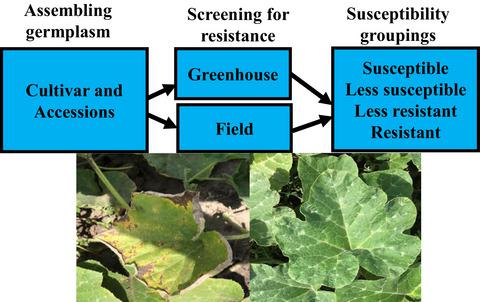当前位置:
X-MOL 学术
›
Plant Pathol.
›
论文详情
Our official English website, www.x-mol.net, welcomes your
feedback! (Note: you will need to create a separate account there.)
Screening and identification of Cucurbita germplasm resistant to Xanthomonas cucurbitae, incitant of cucurbit bacterial spot
Plant Pathology ( IF 2.3 ) Pub Date : 2021-08-04 , DOI: 10.1111/ppa.13445 S. Sulley 1 , Y. Huang 2 , S. R. Hind 1 , M. Babadoost 1
Plant Pathology ( IF 2.3 ) Pub Date : 2021-08-04 , DOI: 10.1111/ppa.13445 S. Sulley 1 , Y. Huang 2 , S. R. Hind 1 , M. Babadoost 1
Affiliation

|
Bacterial spot of cucurbits, caused by Xanthomonas cucurbitae, is an emerging disease of cucurbits. This study was conducted to identify Cucurbita species that are resistant to X. cucurbitae. We developed a reliable method for inoculating cucurbit plants by spraying plants with X. cucurbitae suspensions containing carborundum. Symptoms of the disease developed within 7 days after inoculation. Subsequently, we evaluated the virulence of six isolates of X. cucurbitae in the greenhouse and observed that X. cucurbitae isolated from cucurbit fields in Illinois, Michigan, Kansas, Ohio, and Wisconsin were more virulent than the reference ATCC 23378 strain. Then, we screened 81 commercial cultivars of gourds, pumpkins, and squashes, as well as 300 Cucurbita spp. accessions, for their resistance to X. cucurbitae under greenhouse and field conditions. In the greenhouse study, all commercial cultivars and some of the accessions developed typical symptoms of bacterial spot disease, while some of the accessions developed fewer lesions. In the field studies, infection of leaves and fruits was caused by both natural inoculum and spray-inoculation of plants with a suspension of the X. cucurbitae isolate from Illinois. Among 300 accessions tested, 9 and 21 accessions were classified as resistant and less resistant, respectively. Resistant and less resistant accessions belong to the species Cucurbita maxima, C. maxima subsp. maxima, C. maxima subsp. andreana, and C. okeechobeensis subsp. martinezii. This is the first report of potential resistance to bacterial spot of cucurbits.
中文翻译:

葫芦科细菌斑病诱因葫芦科植物种质的筛选与鉴定
葫芦巴菌斑病是由葫芦科黄单胞菌引起的一种新出现的葫芦科病害。本研究旨在鉴定对X有抗性的葫芦科植物。葫芦科。我们开发了一种通过向植物喷洒X来接种葫芦科植物的可靠方法。含有金刚砂的葫芦科悬浮液。该病的症状在接种后 7 天内出现。随后,我们评估了 6 个X分离株的毒力。温室中的葫芦科植物,并观察到X . 葫芦科从伊利诺伊州、密歇根州、堪萨斯州、俄亥俄州和威斯康星州的葫芦科植物中分离出的菌株比参考 ATCC 23378 菌株的毒力更强。然后,我们筛选了 81 个葫芦、南瓜和南瓜的商业栽培品种,以及 300 个葫芦科植物。加入,因为他们对X的抗性。温室和田间条件下的葫芦科植物。在温室研究中,所有商业栽培品种和一些种质都出现了细菌性斑点病的典型症状,而一些种质发生的病斑较少。在田间研究中,叶子和果实的感染是由自然接种物和用X悬浮液对植物进行喷雾接种引起的。葫芦科与伊利诺伊州隔离。在测试的 300 个种质中,9 个和 21 个种质分别被归类为抗性和抗性较低。耐抗性较差种质属于种笋瓜,Ç。最大值亚种 最大值,C。最大值亚种 andreana,和Ç。okeechobeensis亚种 martinezii。这是首次报道葫芦科植物对细菌性斑点病的潜在抗性。
更新日期:2021-08-04
中文翻译:

葫芦科细菌斑病诱因葫芦科植物种质的筛选与鉴定
葫芦巴菌斑病是由葫芦科黄单胞菌引起的一种新出现的葫芦科病害。本研究旨在鉴定对X有抗性的葫芦科植物。葫芦科。我们开发了一种通过向植物喷洒X来接种葫芦科植物的可靠方法。含有金刚砂的葫芦科悬浮液。该病的症状在接种后 7 天内出现。随后,我们评估了 6 个X分离株的毒力。温室中的葫芦科植物,并观察到X . 葫芦科从伊利诺伊州、密歇根州、堪萨斯州、俄亥俄州和威斯康星州的葫芦科植物中分离出的菌株比参考 ATCC 23378 菌株的毒力更强。然后,我们筛选了 81 个葫芦、南瓜和南瓜的商业栽培品种,以及 300 个葫芦科植物。加入,因为他们对X的抗性。温室和田间条件下的葫芦科植物。在温室研究中,所有商业栽培品种和一些种质都出现了细菌性斑点病的典型症状,而一些种质发生的病斑较少。在田间研究中,叶子和果实的感染是由自然接种物和用X悬浮液对植物进行喷雾接种引起的。葫芦科与伊利诺伊州隔离。在测试的 300 个种质中,9 个和 21 个种质分别被归类为抗性和抗性较低。耐抗性较差种质属于种笋瓜,Ç。最大值亚种 最大值,C。最大值亚种 andreana,和Ç。okeechobeensis亚种 martinezii。这是首次报道葫芦科植物对细菌性斑点病的潜在抗性。































 京公网安备 11010802027423号
京公网安备 11010802027423号